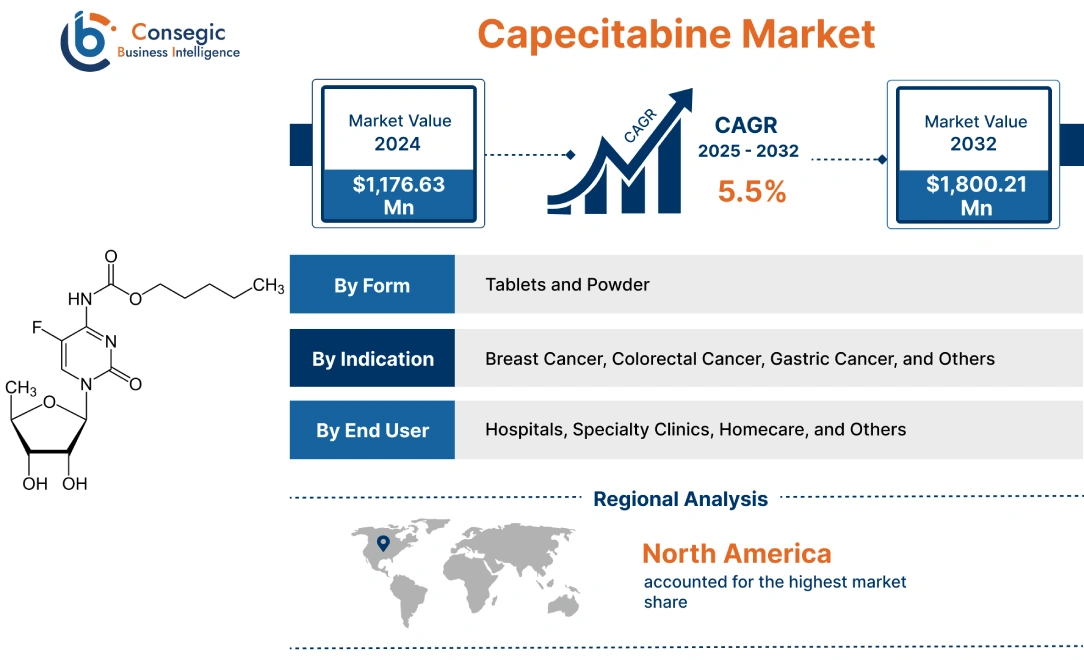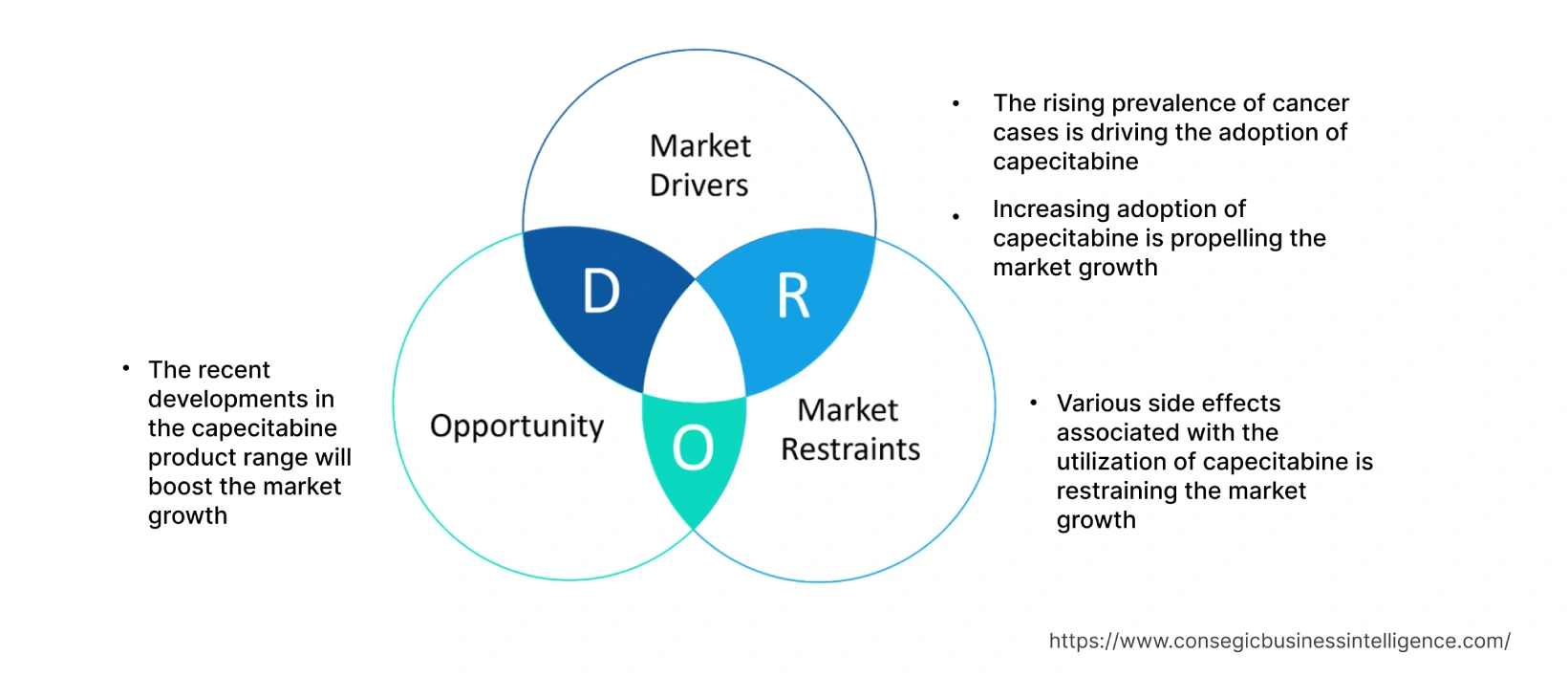- Summary
- Table Of Content
- Methodology
Capecitabine Market Size :
Consegic Business Intelligence analyzes that the capecitabine market size is growing with a healthy CAGR of 5.5% during the forecast period (2025-2032), and the market is projected to be valued at USD 1,800.21 Million by 2032 from USD 1,176.63 Million in 2024.
Capecitabine Market Definition & Overview:
Capecitabine is an anticancer medication utilized to treat various types of cancers such as gastric cancer, breast cancer, and colorectal cancer, among others. The deployment of capecitabine for the treatment of cancer slows or stops the growth of cancer cells. Moreover, capecitabine is employed in combination with other cancer treatments to prevent pancreatic cancer reoccurrence after surgery. Thus, capecitabine efficiently interferes with the advancement of cancer cells, which are destroyed by the body in due course. The two major forms of capecitabine include tablets and powder. As a result of the above benefits, capecitabine is frequently utilized in various healthcare facilities, including hospitals, specialty clinics, homecare, and many more.
Capecitabine Market Insights :
Key Drivers :
The rising prevalence of cancer cases is driving the adoption of capecitabine
The cancer cells frequently need to make and repair DNA. This results in cancer growth and multiply in the other body parts. Hence, the utilization of capecitabine is vital for cancer patients to prevent cells from making and repairing DNA. The growing incidence of cancer such as breast cancer, lung cancer, and other types of cancer along with the rising demand for therapeutics research and development (R&D) for the treatment of cancer are key factors driving the adoption of capecitabine. For instance, according to the recent data published by the Global Cancer Observatory, the number of new cancer cases at the global level reached 19,292,789 in 2020. In 2020, the most common types of cancer were breast cancer accounting for 11.7% of the total cases, followed by lung cancer at 11.4%, colorectum cancer at 10%, prostate cancer at 7.3%, and stomach cancer at 5.6% of the total cases respectively. Thus, the increasing prevalence of cancer cases at the global level is accelerating the demand for capecitabine to prevent cancer from spreading in vital body parts. This, in turn, is supplementing the market growth.
Increasing adoption of capecitabine is propelling the market growth
The key benefits associated with capecitabine include disease progression prevention, increases overall survival, and others. The treatment with capecitabine ensures significantly higher response rates and has the benefit of oral administration. Thus, due to the above benefits the deployment of capecitabine is increasing in hospitals. For instance, Mid Cheshire Hospitals NHS Foundation Trust is a cancer treatment hospital in the United States. The hospital utilizes Capecitabine (Xeloda) for the treatment of cancer. The hospital is actively forming collaborations with leading capecitabine to ensure an efficient supply of medication. Hence, the increasing adoption of capecitabine in hospitals before or after surgery is accelerating market growth.
Key Restraints :
Various side effects associated with the utilization of capecitabine is restraining the market growth
Capecitabine has beneficial effects for cancer treatment. However, the utilization of capecitabine can pose various side effects for patients. For instance, according to the Mayo Foundation for Medical Education and Research (MFMER), the common side effects of capecitabine include diarrhea, loss of fingerprint, nausea, numbness, stomach pain, unusual tiredness or weakness, and vomiting. Furthermore, the rare side effects of capecitabine include agitation, back pain bleeding & bruising, bleeding gums, blood in the urine or stools, bloody nose, and others. These side effects can have serious implications on the patient's health. Therefore, the above side effects associated with capecitabine are posing a bottleneck for market growth during the forecast period.
Future Opportunities :
The recent developments in the capecitabine product range will boost the market growth
The leading market players in the capecitabine market are substantially deploying a strategy for innovations in capecitabine, which are utilized for the efficient treatment of cancer. Therefore, companies dealing in the capecitabine product range are developing new products with new developments. Thus, the introduction of new products with upgraded benefits will create a potential opportunity for the expansion of the global capecitabine market. For illustration, in January 2022, LCHEPLAPHARM Arzneimittel GmbH, a pharmaceuticals manufacturer in Germany launched Xeloda (capecitabine) in the global market. As a result, the innovations in the capecitabine product range will create a prominent opportunity for market growth in the coming years.
Capecitabine Market Report Insights :
| Report Attributes | Report Details |
| Study Timeline | 2019-2032 |
| Market Size in 2032 | USD 1,800.21 Million |
| CAGR (2025-2032) | 5.5% |
| By Form | Tablets and Powder |
| By Indication | Breast Cancer, Colorectal Cancer, Gastric Cancer, and Others |
| By End User | Hospitals, Specialty Clinics, Homecare, and Others |
| By Region | North America, Europe, Asia-Pacific, Latin America, and Middle East & Africa |
| Key Players | Teva Pharmaceuticals, Inc, F. Hoffmann-La Roche AG, Mylan N.V., Hikma Pharmaceuticals PLC, Cipla Inc., Dr. Reddy's Laboratories Ltd., Fresenius SE & Co. KGaA, Sun Pharmaceutical Industries Limited, Genentech, Inc., and Accord Healthcare Ltd. |
Capecitabine Market Segmental Analysis :
By Form :
The form segment is categorized into tablets and powder. In 2024, the tablets segment accounted for the highest market share in the capecitabine market. Capecitabine tablets are easy to pack in travel dispensers per pack. This results in convenience fitting in a bag or pocket. Thus, the major advantage of a capecitabine tablet is its ease of use. In addition, the deployment of capecitabine tablets ensures high precision, dose accuracy, and lower variability, among others. Additionally, tablets are easier to swallow, and, in some cases, they can easily dissolve in water for feeding patients such as children. Capecitabine tablets are utilized for the treatment of lung cancer. For instance, according to the International Agency for Research on Cancer, a total of 1,470,274 new cases of cancer were recorded in Latin America in 2021. Among these, the most common type of cancer diagnosed in the region was lung cancer at 6.6%. Therefore, the increasing prevalence of lung cancers is fostering the demand for capecitabine tablets to ensure ease of use, which, in turn, is driving the market growth.
However, the powder segment is projected to be the fastest-growing segment during the forecast period. This is due to the increasing research and development activities for the adoption of the capecitabine powder at the global level, which is augmenting segmental growth.
By Indication :
The indication segment is categorized into breast cancer, colorectal cancer, gastric cancer, and others. In 2024, the breast cancer segment accounted for the highest market share in the capecitabine market and is expected to be the fastest-growing segment during the forecast period. Capecitabine is utilized by healthcare facilities to treat breast cancer that has reoccurred after previous treatment and has spread to the tissues & lymph nodes around the chest, neck, and others. Additionally, capecitabine is deployed for the treatment of early-stage triple-negative breast cancer. For instance, according to the recent statistics published by the Global Cancer Observatory, approximately 4,398,443 new cases of cancer were detected across Europe in 2020. Among these, 2,339,617 new cases were diagnosed in the Europe male population. The most common types of cancer diagnosed in Europe in 2020 were breast cancer accounting for 12.07% of the total cases. Thus, the increasing prevalence of breast cancer cases is boosting the demand for capecitabine to control the spreading of breast cancer. This prominent factor is amplifying the market growth.
By End-User :
The end user segment is categorized into hospitals, specialty clinics, homecare, and others. In 2024, the hospitals segment accounted for the highest market share of 48.50% in the overall capecitabine market. Capecitabine has been approved for utilization by various international nodal agencies such as the United States Food and Drug Administration (FDA), European Union, and others. Capecitabine is a crucial component of several cancer chemotherapeutic regimens. Thus, capecitabine is deployed in the treatment of various types of cancers in hospitals, including advanced & metastatic breast cancer, colorectal cancers, and others. For instance, in November 2022, the Indian government inaugurated the Homi Bhabha Cancer Hospital in Chandigarh, India. The hospital was built at a cost of over USD 88.6 million and has a total bed capacity of 300 patients at a time. Additionally, in January 2023, the government of Poland invested USD 576.2 million for the expansion of cancer hospitals across the country. Henceforth, the rising development of hospitals providing cancer treatment, including breast cancer, colorectal cancer, and others is expected to increase the adoption of capecitabine in hospitals for the efficient treatment of cancer, thereby, driving the growth of the market in the upcoming years.
However, the specialty clinics segment is expected to be the fastest-growing segment during the forecast period. This growth is attributed to factors such as increasing investment in new specialty clinic facilities, increasing government initiatives, and others.
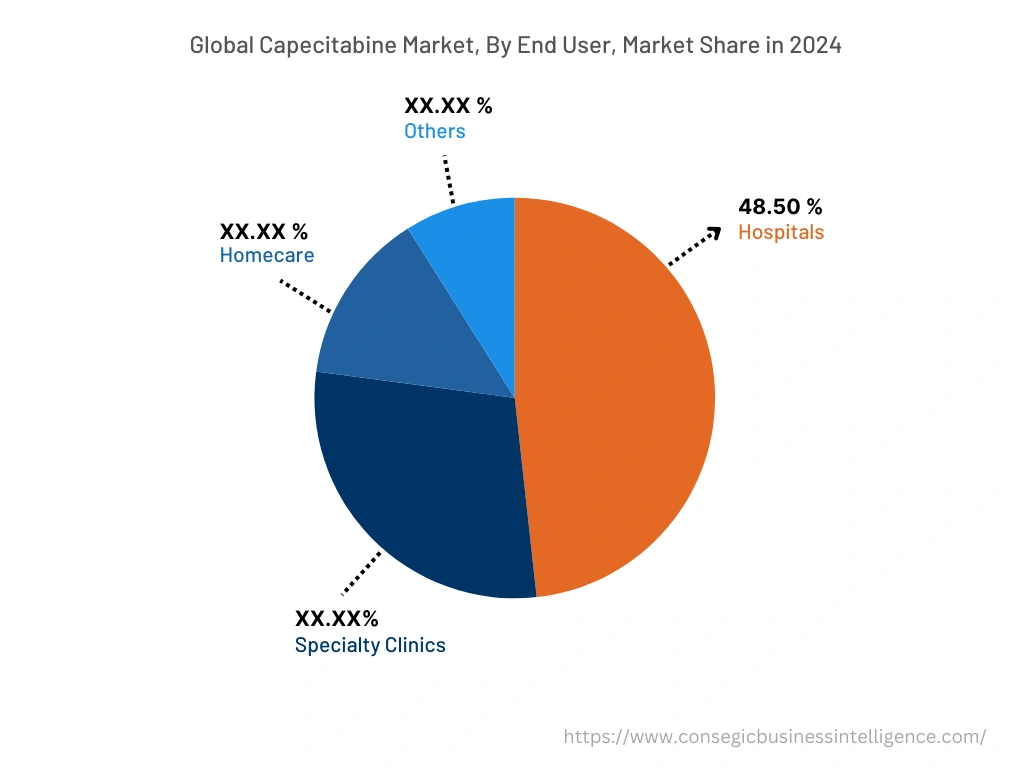
By Region :
The regional segment includes North America, Europe, Asia Pacific, Middle East and Africa, and Latin America.
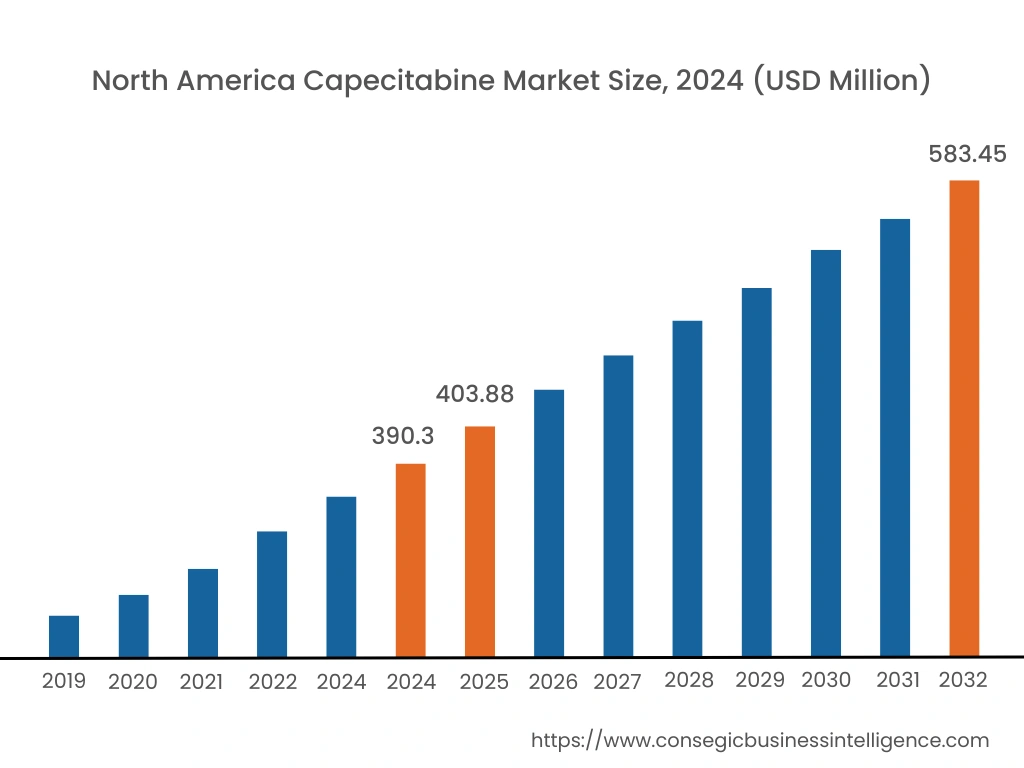
In 2024, North America accounted for the highest market share at 38.60% and was valued at USD 390.3 million, and is expected to reach USD 583.45 million in 2032. In North America, the U.S. accounted for the highest market share of 65.50% during the base year of 2024. This growth is attributed to factors such as the increasing prevalence of cancer cases, the rising development of new products, and others. For instance, according to the American Cancer Society, approximately 800 to 900 new cases of osteosarcoma, which is a type of cancer that affects the bone, are identified in the United States each year, among which, half of the cases occur in teenagers and children. Meanwhile, according to the Global Cancer Observatory, approximately 195,499 new cases of cancer including colorectal cancer, lymphoma, lung cancer, and breast cancer among others were recorded in Mexico in 2021. As a result, the increasing prevalence of cancer cases in the North American region is favoring the capecitabine market growth in the region.
Furthermore, Asia Pacific is expected to witness significant growth over the forecast period, growing at a CAGR of 6.1% during 2025-2032. The prime factors such as the presence of key players in the Asia Pacific region, advancement in capecitabine manufacturing, and others are boosting the market growth in the Asia Pacific region.
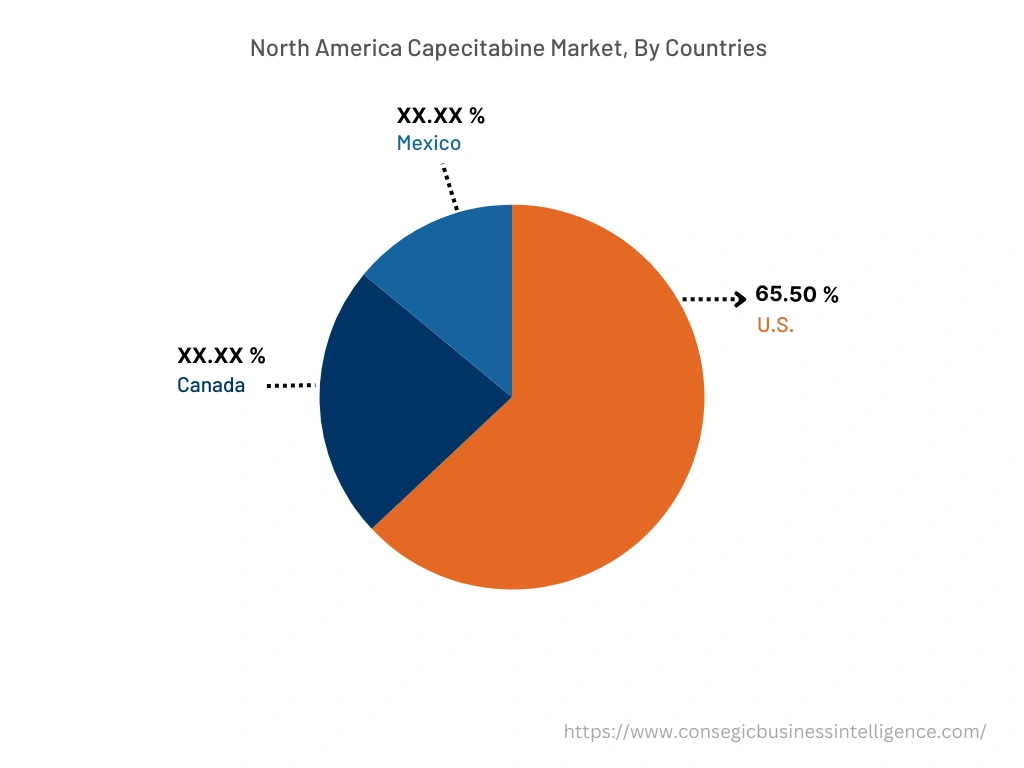
Top Key Players & Market Share Insights:
The capecitabine market is highly competitive, with several large players and numerous small and medium-sized enterprises. These companies have strong research and development capabilities and a strong presence in the market through their extensive product portfolios and distribution networks. The market is characterized by intense competition, with companies focusing on expanding their product offerings and increasing their market share through mergers, acquisitions, and partnerships. The key players in the market include-
- Teva Pharmaceuticals, Inc
- F. Hoffmann-La Roche AG
- Sun Pharmaceutical Industries Limited
- Genentech, Inc.
- Accord Healthcare Ltd.
- Mylan N.V.
- Hikma Pharmaceuticals PLC
- Cipla Inc.
- Dr. Reddy's Laboratories Ltd.
- Fresenius SE & Co. KGaA
Recent Industry Developments :
- In February 2021, Dr. Reddy's Laboratories Ltd., an India-based manufacturer of capecitabine launched a generic version of Xeloda (capecitabine) tablets in the United States market. Thus, the expansion of product offerings in the global market is benefiting the capecitabine market growth.
Key Questions Answered in the Report
What was the market size of the capecitabine industry in 2024? +
In 2024, the market size of capecitabine was USD 1,176.63 million.
What will be the potential market valuation for the capecitabine industry by 2032? +
In 2032, the market size of capecitabine will be expected to reach USD 1,800.21 million.
What are the key factors driving the growth of the capecitabine market? +
The rising prevalence of cancer cases is driving the adoption of capecitabine, which is fostering market growth.
What is the dominating segment in the capecitabine market by end user? +
In 2024, the hospitals segment accounted for the highest market share of 48.50% in the overall capecitabine market.
Based on current market trends and future predictions, which geographical region is the dominating region in the capecitabine market? +
North America accounted for the highest market share in the overall capecitabine market.
